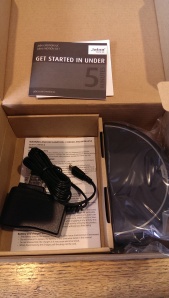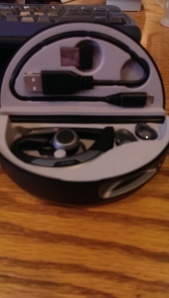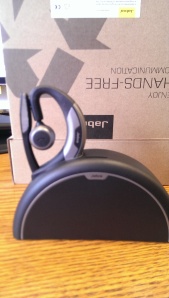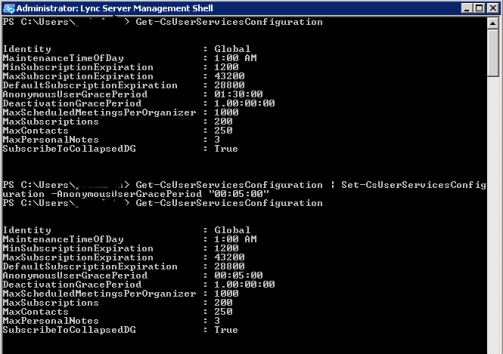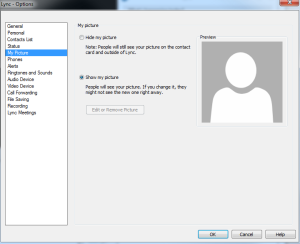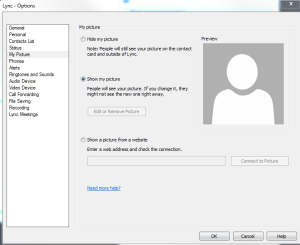Archive
Hotfix for Lync for Mac 2011 14.0.10
This is a hotfix that you can apply to your Mac if you are running 14.0.10. From the folks I have helped deploy this to, it makes a significant improvement.
http://support.microsoft.com/kb/3019983
The funny part about this is that the hotfix comes as a .exe file which is not native to Mac’s. In order to extract it, open a command window and use the Unzip command, i.e. “unzip hotfix.exe”.
One of the first things I noticed that was fixed in this is that screen shares are much faster and smoother. A co-worker reported to me that he sees less crashes with the Mac for Lync client.
The fact that this is a hotfix instead of just a patch makes it so you have to install it manually. In my opinion, every Mac for Lync user should install this.
Lync and Site specific Simple URL’s
We recently had a requirement when deploying a new Lync 2013 pool to give a Site/Region their own Simple URL’s. I knew this could be done and it’s always easier when doing it during the deployment but this was the first time I had ever had to do it when the site had been running for awhile on Lync 2010 and using the Global Simple URL’s.
Our requirement was to go from using the Global Simple URL (meet.company.com) to a Regional based one of meet-emea.company.com.
I went and double-checked Technet (as everyone should do) and also referenced an article by Justin Morris from awhile back that was specific to configuring site level Simple URL’s.
All of the info is great but it was lacking one thing, how to make sure that the old Simple URL would still work after we made the change. We did not want to have to have a flash cut where everyone had to go update their recurring meetings and the like.
In the Technet article for creating the new Simple URL is this tidbit:
| SimpleUrlEntry | Optional | Collection of URLs for the specified component. For example, both https://meet.litwareinc.com and https://litwareinc.com/meet might be configured as URL entries for the Meet component. However, only one of those URLs can be (and must be) configured as the active URL.
Simple URL entries must be created by using the New-CsSimpleUrlEntry cmdlet. |
It specifically states that you can define a “Collection of URLs for the specified component”. That’s the ticket! However, the Technet example didn’t show how to add multiple URLs. Here is what I found worked:
$urlEntry= New-CsSimpleUrlEntry -url "https://meet-emea.company.com"
$urlEntry1 = New-CsSimpleUrlEntry -url "https://meet.company.com"
$urlEntry2 = New-CsSimpleUrlEntry -url "https://dialin-emea.company.com
$simpleURLMeet = New-CsSimpleUrl -Component meet -domain company.com -ActiveUrl "https://meet-emea.company.com" -simpleurl $urlEntry,$urlEntry1
$simpleURLDialin = New-CsSimpleUrl -Component dialin -domain * -ActiveUrl "https://dialin-emea.company.com" -simpleurl $urlEntry2
Set-CsSimpleUrlConfiguration -Identity "site:MySite" -SimpleUrl @{Add=$simpleURLMeet,$simpleURLDialin}
After we had done all of this, we went and tested and everything appeared to work fine. We shall see if there are any issues from a users stand point that we we were unable to replicate using our test accounts.
Reflections on Best of #Lync Conf Denver #COUCUG
Yesterday, (April 24th), was the Best of Lync Conference Denver. As a leader of the Colorado Unified Communications User Group, I was involved in the planning, setup and execution of putting this event on. I wanted to take a moment to reflect on what we accomplished.
First, we had a goal of 40 attendees. We ended up with 48 or 49 plus the sponsors and leaders of the user group for a grand total of 58. We did this with about a months worth of planning and invitations. Based on the amount of effort that was put into just this, I have to say my admiration and and respect (which was already pretty big) for Jamie Start (@nomorephones) and his team has been exponentially magnified. I have no idea how they have pulled off the real LyncConf the past two years without going absolutely crazy. Seriously, that team must be amazing.
Second, we had a pretty major curve thrown at us in that we had to share the Microsoft Offices with the “Microsoft Day of Unity” folks. This means we had approximately another 60 people in the office sharing the already constrained Internet connection (I’ll get to why this is important in a minute). We had to coordinate different food stations and be good neighbors as our rooms were right next to each other.
Since we only ended up with one room that could hold more than 10-12 people, we made a last minute decision to trim some sessions down and deliver everything from the one room instead of breaking things up and having both a business and technical track. This proved to be a wise-decision because everyone was able to get info from all of the sessions.
Remember that whole having to share the Internet thing? Well, we were fortunate enough to be able to have Jeff Schertz (@jdscher) speak to us. He delivered his “Video – What are you doing on my network?” presentation that he gave at the LyncConf. We brought him in via a Lync meeting and used a Polycom LRS unit. The LRS was on the same network as 100+ other people doing nothing but best effort. Our voice quality with him was fantastic! Yes, video was choppy but we were able to hear him and see his presentation the entire time. Huge win and a great job by Jeff. I can’t say how much I appreciated him being able to speak to us. His community focus is awesome.
We had three sponsors (outside of Microsoft). Jabra (@We_are_Jabra), AudioCodes (@audiocodes) and Clarity Consulting (@claritycon) helped us out. Clarity and AudioCodes sponsored the breakfast and lunch meals and then Jabra gave away 4 devices. The help from Claire, Lindsey, and Rose was tremendous. They helped direct people and answer questions. I truly hope people were able to talk with them and see how each of them could help with a company’s UC rollout.
Lastly, I can’t say enough about the team that contributed to the success of the event. We had help from so many places. I really hope everyone who attended got a lot out of the event. I think we had some fantastic content and some outstanding presenters. I’m excited to be entering year 4 of the user group here in May and can’t wait to see what the future holds.
Thank you!
Jabra Motion UC [Initial Thoughts]
The good folks at Jabra sent me a stack of devices that I will be working my way through. This is my first impressions with the Jabra Motion UC device.
My day job requires me to be on the phone a lot. I work from home most days and use a headset or speaker phone for an average of 4-5 hours per day. A good headset and a speaker phone are a must. There are a few requirements that I have to have:
- Microsoft Lync Optimized
- Good sound
- Good noise cancellation
The Jabra Motion UC meets all of these plus it gives one major advantage over its competitors, its range. It uses Bluetooth Class 1 which gives it well over 100ft range (enough that I could walk two flights up in my house while on a call and not have any issues). The range on it is by far my favorite “feature”. I can now go and make coffee while on a call without issue (I have a lot of calls where I am just listening versus being an active participant).
If the range wasn’t so impressive, the first thing I would have commented on would be its weight. It is lighter than my previous device. While we are talking about a matter of an ounce or less, the weight of a headset on your ear is noticeable at the end of a long day.
Here is the un-boxing. Small box which is nice. I get tired of companies packing small items in large boxes. Everything fits nice and snug and has good visual appeal as you open it. They could probably even make the box smaller and use less materials and I would challenge them to do so.
The case holds everything you need to take it with you. Everything has a place and it is not an issue to fit things back for when you need to be on the go.
The case for the device is also the desktop cradle which is nice. Plug in your USB and it sits at the ready.
Based on a days worth of use (many more will be coming), my initial thought is that it is a great device. There are some trade-offs to my previous headset. First, the USB mount for the charging cradle. This is a double-edge sword. While on the desktop, a better dock (i.e. a magnetic charging station) is much nicer but if you are on the go a lot, having a standard mini-USB without having to find a specific adapter is nice. I do wish the case had a battery in it to charge the device while in my bag as well. These two items are merely differences between my current device and the UC Motion. They aren’t deal killers by any means.
I will note, from a functionality standpoint, that the mute button is in an awkward spot at the base of the mic boom. I feel like I’m rubbing my fingers over the mic as I try to hit mute. This could introduce a scratching noise to the call until mute is activated. We’ll see how this goes over time and if I will get use to it.
Installing the Jabra Control Center (aka PC Suite) is a must. The Jabra Control Center allows you to manage features of the device and do firmware upgrades. A first step for me using the Control Center was to disable the Mute Reminder. Having it beep in your ear every 20 or 30 seconds to remind you that you are on mute is just annoying. I understand the need but that frequency was just too often. Once you apply that setting, you do need to connect the headset to the computer via USB for it to apply the change.
I’m looking forward to using the Motion UC more over the coming weeks. I’ll report back once I have logged a significant number of hours with it.
Find #Lync Versions
Awhile back, a tool called Find Lync Versions was released. This tool was pretty helpful in finding out what versions of Lync were registering to a server. For me specifically, it helped me find a bunch of old CX700 phones that were connecting with OCS versions of Lync Phone Edition. I recently went to find it again and the site that it was hosted on was gone. I used the Way Back Machine and an old copy I had to use it again recently. Thought I would re-post the directions for it as its main feature was a SQL Query against the RTCLocal database. Since I don’t know the original author nor do I have their permission, I am not going to re-publish the zip file publicly. Hopefully the original author can re-post it or the source code somewhere.
https://web.archive.org/web/20121014145841/http://www.stumper66.com/software/lync.html
If you have Lync server installed, you’ll find it’s not very easy to find the client versions.
This simple program makes it very easy.
All Lync data is aquired by querying the SQL database RTCLocal.
Optional features:
- Active directory – Resolve email addreses to user names.
- DNS – Resolve IP addresses to computer names.
Note: .NET 4.0 required.
To configure, specifiy server name and SQL instance.
Here are the only SQL queries that the program executes:
USE [rtcdyn]
SELECT UserAtHost, ClientApp, EndpointId, ContactInfo FROM RegistrarEndpoint T1
LEFT OUTER JOIN rtc..Resource T2 ON T1.OwnerId = T2.ResourceId
WHERE IsServerSource = 0 ORDER BY UserAtHost
For Legacy (OCS) servers:
USE [rtcdyn]
SELECT UserAtHost, ClientApp, EndpointId, ContactInfo FROM Endpoint T1
LEFT OUTER JOIN rtc..Resource T2 ON T1.OwnerId = T2.ResourceId
WHERE IsServerSource = 0 ORDER BY UserAtHost
#Lync Conferencing Anonymous User Time-out
Ran into this awhile back and documented it in my “To Blog” note pile. Client wanted to know how long someone who isn’t the meeting owner (i.e. a guest from another company) could stay in a meeting before they were kicked out if the meeting owner (aka Presenter) dropped. I found this article on Technet: http://technet.microsoft.com/en-us/library/gg398340.aspx and it explained the following:
AnonymousUserGracePeriod:
Represents the amount of time an anonymous (unauthenticated) user can remain in a meeting without an authenticated user being present in that same meeting. For example, if this value is set to 15 minutes an anonymous user can stay in the meeting for, at most, 15 minutes before an authenticated user must join. If an authenticated user does not join before the grace period expires then the anonymous user will be removed from the meeting. This setting applies to both scheduled meetings and to ad-hoc meetings created by clicking Meet Now in Microsoft Lync.
The AnonymousUserGracePeriod must be specified using the following format: days.hours:minutes:seconds (for example, 0.00:30:00 for 30 minutes). The grace period can be set to any value between 0 second and 1 day; the default value is 90 minutes (01:30:00).
Note that the default value is 90 minutes. That means if you have people in a call and all of the authenticated users drop, the non-authenticated users could continue to chat for 90 more minutes.
For this particular client, they wanted to ensure that if an authenticated user (aka Presenter) dropped from the call, that the other non-authenticated (aka Guests) user would drop after 5 minutes. We achieved this using the following command:
Get-CsUserServicesConfiguration | Set-CsUserServicesConfiguration -AnonymousUserGracePeriod "00:05:00"
Lync Debugging Tools updated
My good friend Jonathan McKinney originally posted this article about the Lync Debugging tools:
http://blog.lyncdialog.com/2013/03/inboundrouting-and-outboundrouting-does.html
In the article he notes that you should copy the default.tmx file from C:\Common Files\Microsoft Lync Server 2013\Tracing to the folder where the Debugging tools are installed as the default.tmx file that shipped with the Debugging Tools was only ~5Mb in size.
Well, I was following this advice as I always do and when I noticed that on this fresh install of the Debug tools, the default.tmx file was ~22Mb big. I went back and checked, and sure enough, the Debugging tools were updated on 1/8/2014. You can get them here:
http://www.microsoft.com/en-us/download/details.aspx?id=35453
COUCUG January Meeting (1/30)
The January meeting of the Colorado Unified Communications User Group (COUCUG) will be held on January 30th from 4-6pm at the Microsoft offices in the DTC. Plantronics will be sponsoring the meeting and will be providing food and drinks.
Our topics this month are:
- Lync Meeting Etiquette
- Deploying Lync Voice
Please RSVP at www.coucug.org so we can bring in the right amount of food.
We’re looking forward to a great year with lots of great topics and hope you will join us.
#Lync for Mac 14.0.7 Bug
Just a quick heads up, if you are running Lync for Mac 14.0.7 and you unplug a USB Audio Device (i.e. Plantronics headset, etc), Lync will crash. Found this at a client and had a few co-workers confirm. Hopefully Microsoft will get that fixed quickly but I’m guessing we will have to wait until 14.0.8 in three months.
UPDATE: It has been confirmed as a bug and should be fixed when 14.0.8 is released (sometime in Q1-2014).
#Lync 2013 and Display Photo from Website
This was a feature that was removed in the Lync 2013 client that many people had used in Lync 2010. Well, with the November 2013 Update, it’s back! One thing though, you have to enable it via policy (source: http://masteringlync.com/2013/11/11/lync-client-cu3-november-update-show-a-picture-from-a-website/):
$PolicyEntry=New-CsClientPolicyEntry -Name EnablePresencePhotoOptions -Value true
$currentClientPolicy=Get-CsClientPolicy -Identity Global
$currentClientPolicy.PolicyEntry.Add($PolicyEntry)
Set-CsClientPolicy -Instance $currentClientPolicy
Before you run this, here is what you will see:
After you run the code snippet:
I know many people have been clamoring for this since the release of Lync 2013. Glad to see it back!
